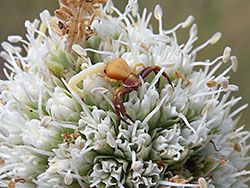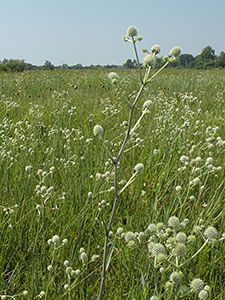Rattlesnake Master

Whitebanded Crab Spider on Rattlesnake Master bloom, Nash Prairie © Don Verser
Eryngium yuccifolium
Family: Apiaceae (Carrot Family)
Rattlesnake Master (Eryngium yuccifolium) is a striking native perennial found throughout the prairies and open woodlands of Texas, including Southeast Texas. Despite its name, it is not a true yucca, but its sword-like leaves and bold flower heads make it a standout plant in native landscapes. Historically, Native Americans used the plant for medicinal purposes, adding to its cultural significance.
- Scientific Name: Eryngium yuccifolium
- Common Names: Rattlesnake Master, Button Eryngo
- Family: Apiaceae (Carrot Family)
- Growth Habit: Upright, clump-forming perennial
- Height: 3-5 feet
- Leaves: Long, narrow, yucca-like with spiny edges
- Flowers: Globe-shaped, silvery-white flower heads on tall stalks
- Bloom Time: Summer (June to August)
- Wildlife Benefits: Attracts a variety of pollinators, especially bees and butterflies
Habitat & Range in Southeast Texas

Rattlesnake Master at Deer Park Prairie © Don Verser
Rattlesnake Master naturally occurs in:
- Tallgrass Prairies: Thrives in sunny, open areas with well-drained soils
- Savannas & Meadows: Common in native prairie remnants
- Roadsides & Restored Habitats: A reliable species for native plantings
This species prefers dry to moderately moist soils and is drought-tolerant once established.
Ecological Importance
- Pollinator Magnet: Supports native bees, butterflies, and other beneficial insects.
- Biodiversity Boost: Adds diversity and resilience to prairie plant communities.
- Cultural Significance: Historically used for medicinal purposes by Indigenous peoples.
Landscaping & Gardening Uses
Rattlesnake Master adds bold texture and architectural interest to native gardens:
- Native Prairie Gardens: A keystone species in tallgrass prairie restorations.
- Pollinator Gardens: Long-lasting blooms provide essential nectar resources.
- Drought-Resistant Plantings: A hardy addition to xeriscapes and low-water landscapes.
Planting & Care
- Sunlight: Full sun
- Soil: Well-drained soils; tolerates poor and rocky soil
- Water Needs: Low to moderate; very drought-tolerant
- Maintenance: Minimal; cut back in winter to encourage new growth
- Companion Plants: Pairs well with Little Bluestem (Schizachyrium scoparium), Purple Coneflower (Echinacea purpurea), and Black-eyed Susan (Rudbeckia hirta)
Fun Facts
- Rattlesnake Master gets its name from a historic belief that it could treat rattlesnake bites.
- The plant’s unusual texture and appearance make it a favorite for native plant enthusiasts and landscape designers.
- It belongs to the same family as carrots and parsley but looks more like a yucca.
Conservation & Native Plant Advocacy
Incorporating Rattlesnake Master into your garden or restoration project supports pollinators, enhances biodiversity, and preserves a culturally significant native species.
Where to Find It
-
Interested in adding Rattlesnake Master to your garden? Check if this is in stock or add to cart to purchase directly from our Natives Nursery.


